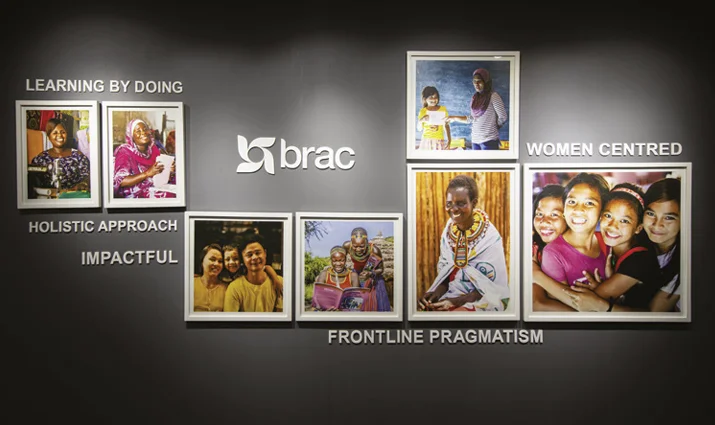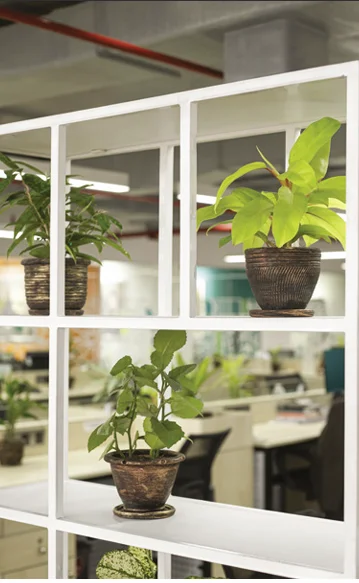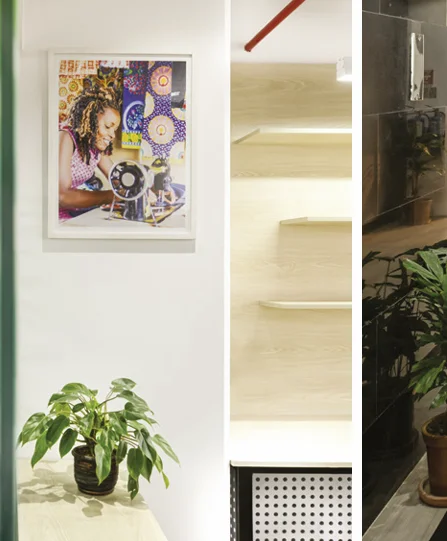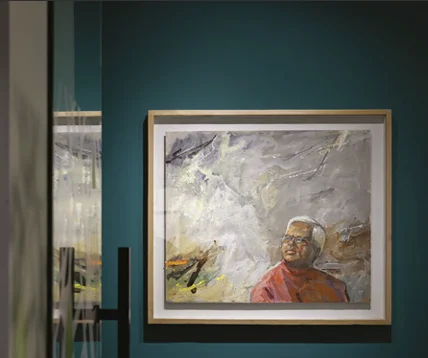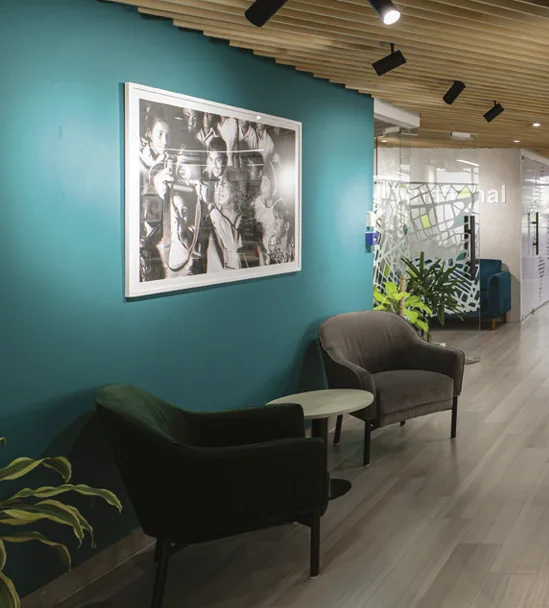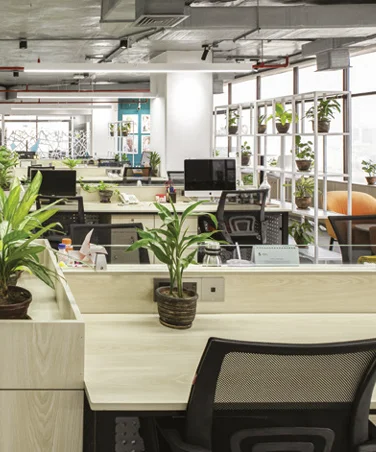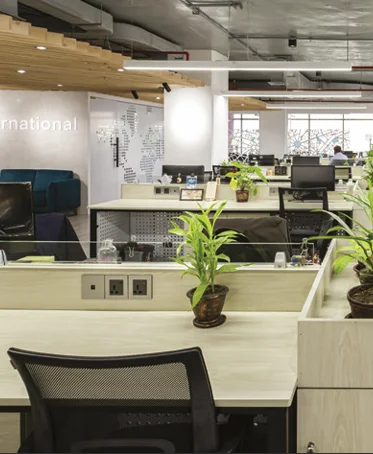Related Posts

The Story Behind Decathlon Dhaka’s Stunning New Office
In the center of Dhaka’s relentless urban sprawl, Decathlon’s new liaison office has carved out an unexpected oasis. Designed by Studio one zero, the two-floor, 20,000-square-foot workspace is a lively yet calming blend of nature, sport, and smart design — a triumph achieved under the intense pressure of a compressed timeline. One floor of the office is devoted to a sprawling seminar and multi-purpose event space, while the other flourishes as a vibrant open-plan workspace. Together, they embody Decathlon’s global brand ethos: movement, accessibility, and connection to the environment. From the first step inside, the design immediately surprises. Natural light pours in from every angle, with open workstations, informal seating zones, and collaborative spaces stretching toward the glass walls. But what truly distinguishes the space is its deliberate, sensitive incorporation of natural elements into an otherwise urban setting — a concept that chief architect Jafor Hoq and Partner Architect Humaira Binte Hannan at Studio One Zero were determined to bring alive. Challenge Against Time “The biggest challenge for us,” says Jafor Hoq, “was the design decision against time. From the initial concept to execution, we had a very short period. And it wasn’t just about filling a space — Decathlon wanted something meaningful, experiential, and true to their brand spirit.” Working under intense deadlines and changes meant that decisions on materials, layouts, and designs had to be made rapidly but thoughtfully. “We had no time for second-guessing. Every material, every design move had to be purposeful and achievable within the timeframe,” Hoq recalls. Instead of battling the constraint, Studio one zero leaned into it, focusing on a few strong ideas and executing them meticulously. Bringing Nature Indoors — A Different Way While biophilic design is no longer a novelty, Studio one zero’s approach for Decathlon’s office is refreshingly nuanced. Instead of merely placing potted plants in corners, nature was embedded into the structure itself. The most striking feature — the tree-inspired columns — originated from a need to solve a technical problem with artistic flair. Existing structural columns, often seen as obstacles in open-plan offices, were transformed into vertical wooden sculptures. “These columns are not just cladded structures,” Hoq explains. “We intentionally gave them the form of large tree trunks, expanding outward at the top, creating a canopy-like feeling. Under these ‘trees,’ we placed high seating zones, making them natural gathering points where people can sit, stand, and connect. It’s about reinterpreting indoor nature — not just bringing in greenery but evoking the experience of being under a tree.” Materiality: Warmth in an Industrial Frame The material palette reflects a thoughtful balance between modernity and warmth. Light oak wood cladding runs through the flooring of common pathways and wraps around key architectural elements, providing a sense of warmth and continuity. “The idea was to humanize the space,” says Hoq. “We were working with an exposed ceiling — which gives that industrial look — but we didn’t want it to feel cold or impersonal. Using wood, texture and incorporating green , was the answer.” Meanwhile, the furniture choices favored light-colored wood and clean lines to complement the architecture without overwhelming it. Lush green walls filled with planters further softened the industrial base, offering breathing spaces that look and feel alive. Even the lighting played into the natural narrative. Angular, dynamic geometric light fixtures, seemingly random yet deliberate, mimic dappled sunlight filtering through tree canopies, casting a playful rhythm of light and shadow across the workspace. Functionality at the Core Of course, Decathlon’s office needed to be more than beautiful; it needed to work. Beyond the seminar space and open workstations, Studio One Zero integrated a variety of amenities including a gym, prayer rooms, a sick room, and a restaurant-style café. The café, with its relaxed seating and natural materials, encourages casual interaction — a deliberate attempt to break down formalities and foster an easy, collaborative culture. Flooring materials shift subtly from wood to textured carpet tiles to indicate different zones without physical barriers, preserving the openness. Every design choice speaks to movement, flexibility, openness and wellness — values at the heart of both Decathlon and Studio one zero’s architectural philosophy. A Space That Moves People In the end, Decathlon’s Dhaka office is more than a workplace. It’s a living, breathing environment, where the boundaries between indoor and outdoor, formal and informal, structured and free-flowing, are beautifully blurred. Studio One Zero’s bold vision — executed under a limited timeframe — has resulted in a space that isn’t just seen; it’s felt. A place where employees can experience the spirit of sport, the calm of nature, and the excitement of innovation, every single day. “We didn’t just design an office,” Jafor Hoq smiles. “We designed an experience.” Written By Fatima Nujhat Quaderi Photo: Truphoto Studio

Prologue to Paerns Emerald Bakery and Cafe
As muffled conversations and. farewell notes of jazz float up to the sky – the baker gets to work. The bassline and flour have charted a path; the stage has been set. Somewhere in the throes of dawn, the musician and baker find harmony. Lost in their fundamental desire to put together ingredients that make magic; they make something anew. The aroma of bread and notes of the accordion dance together; inspiring and emulating. Food and music universal languages that speak to us all. While crossing the busy street of Banani 11 in Dhaka city, you can randomly walk into the recently launched Emerald Bakery and Café. Owned by the family behind Emerald Restaurants, the Emerald Bakery started its journey with a small shop in Uttara back in 2018. It was initiated by Shamima Rahman with her dream of stepping into the bakery market, and moved to a bigger space within the food court at Chef’s Table in Gulshan. But overall Emerald Restaurants is co-owned by Shamima Rahman (mother), Aminur Rahman (father), Shaker Ibne Amin, Sabbir Ibne Amin and Ayeman Ibne Amin (sons). Shaker Ibne Amin found a gem of a location; one of the very few independent houses left that can be used commercially. This opportunity encouraged them to dream of a street-side venture, not confined within a tall structure made of steel, glass, and concrete. Hence with this new thought process, the Emerald Bakery and Café went through a rebranding. The new branding has a core value of using patterns, as suggested by Prianka Ameen, who worked along with the designing firm, Inked Studio, to wrap this concept throughout the whole café and packaging. “Bakery is science, where measurement is the key and patterns are very mathematical by nature. However, we also wanted to make our place cozy and homely, creating an ambiance that one experiences in a family-run bistro. Therefore, perfectly made patterns would be too rigid and organised for us. Therefore, we decided to go with handmade/drawn patterns, where each motif is flawed yet unique. We have taken this concept to drive the whole design process; from branding and our menu to the architecture,” Sabbir Ibne Amin said while explaining his wife’s concept. Before intervening with the venture in a new location they surveyed and studied a lot of human behaviour. That is mostly how Inked Studio works, being a human-centered design studio. Hence, they tried to build a place where one can work individually, plan office meetings, hang out with office colleagues or friends, have family dinners, or just spend a lazy afternoon with a book. These use cases helped generate the design, the seating layouts, lighting, and sound panels, and Parisian-influenced subtle and muted colour palettes, mostly inspired by nature and the colours from their dishes. Patterns have been made on feature walls using simple and rudimentary techniques. Blocks used for drawing patterns on the f loor have been repurposed to see thru panels that separate open spaces. There is a conscious repetition of elements but in a very organic and uneven way. The paintings of different sizes have been printed and framed first before deciding which walls they belonged to, just as the way one buys paintings for our homes. Mostly the paintings chosen are of classic female painters, although famous among art enthusiasts, are not fairly represented to the masses as opposed to their male contemporaries. Therefore, about half the paintings are works of female artists such as Tamara de Lempicka, Irma Stern, Emily Carr, and Suzanne Valadon. Prianka Ameen, the food consultant for Emerald Bakery, worked closely with Mr Ayeman and the chefs to design and develop the menu. As the cafe business is competitive where they have established The Grove Bistro, Gusto, and Trouvaille, Ms Prianka was tasked with designing a menu that could differentiate “us”. “Studying European and North American cafes and bistros, we came up with our very own twist of a concise, healthy, and diverse menu. Our dishes reflect the comfort and homeliness while strengthening the identity of being both a cafe and bakery,” Mr Sabbir added. The architectural project was led by Inked Studios, a design firm where team members from different fields and expertise work collaboratively to design, develop and execute ideas. Designers who worked on this project from Inked including Zehra (anthropology and literature), Auhona and Navid (Architecture), Redwan (Hospitality Management and Client Servicing), Nashad (Art and Visual Design), Ayeman (Business Administration and Entrepreneurship), Sabbir (Mathematics and User Centered Design) and Zara (Business Administration). The brand line for the bakery and café is the food that syncs. Every project under Inked Studio and Emerald Restaurants has a concept and story behind it. As the venture grows old, it changes but the core concept always remains the same, just as a human. Authored by Rehnuma Tasnim Sheefa
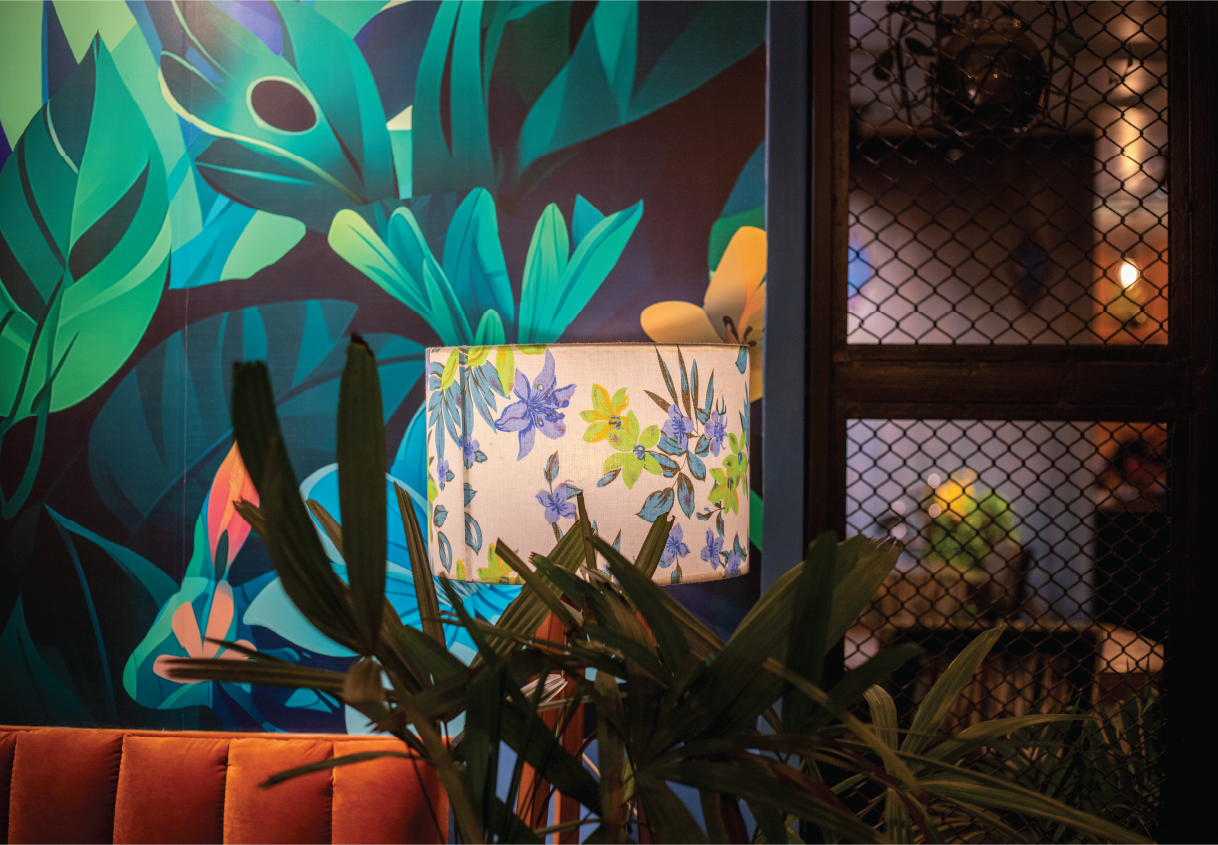
A Journey Of a Thai Culinary Excellence of and Artistic Innovation
We are sure that there are times when you crave some good tangy Thai flavours and also miss the vibrant experience of street life in Thailand. Naming from the famous street of Bangkok, Khao San is such a place where you can meet both. Founded by four friends – Bushra Haque Sarah, Syed Sameem Shahriyar, Taposh Ghosh, and Mustafid Raiyan Khan—Khao San is more than just a dining spot; it’s a passion project. After gaining popularity in Dhanmondi, Khao San has now made its mark in the heart of Gulshan. Despite being open for only a few months, the restaurant has already captured the hearts of diners with its delectable taste and unique interior. With the air infused with tantalising Thai flavours and the atmosphere adorned with bold hues with a pinch of earthy colours, the restaurant interior pays an ode to its famous Thai street namesake, Khao San Road. As guests step into this new branch, they might subconsciously reminisce about the interior of Dhanmondi and immediately be enveloped in a newer enchantment. The restaurant not only draws its name from the famous road but also matches the vibes of the lively and bustling area renowned for its vibrant nightlife and dynamic energy. Through careful design interventions, the restaurant’s interior captures this spirited ambiance, blending the bustling vibe of Khao San Road with a serene touch of nature. We designed Khao San Gulshan with the Dhanmondi branch in mind. We tried to maintain a similar essence,” said Sheefa. Like the debut branch, the interior has been done by Rahnuma Tasnim Sheefa, the principal architect of Parti.Studio. Once you’re inside Khao San Gulshan, you will consciously notice the wooden motifs on the main door, inspired by the lotus flowers of Thailand. The same motif is also reflected in the door knobs of washrooms and a partition door, creating a cohesive design throughout the space. The designer has carefully merged the wooden motifs with the glass, creating a screening that added a modern touch to the usual traditional design element. Upon entering the space, you will be greeted by a vibrant, real tuk-tuk. The dining area is mostly an open plan divided into several zones that are connected visually yet spaced out with mesh dividers and plants. There’s also a private room for larger groups. One of the seating zones features an elevated floor space where you will discover a wall composed of a wooden window with a stunning mural painted inside and designed beside a rustic doorframe. As the architect described, the entire space is very “instagrammable.”. You will find corners or elements to take dope pictures. With splashes of vibrant hues, warm tones, and moody ambient lighting, each nook and cranny has been designed to capture the eyes of the visitors, inviting them to take a closer look and explore the decor. The restaurant design mimics the scenic nature and happening city life of Thailand, interpreted to fit into the theme. Through closer inspection, you will be able to decipher that the city-influenced part of the restaurant has warm tones of orange, red, and yellow. On the other side, the nature part has an upper hand with cool tones of blues and greens. “Throughout the space, we introduced natural plants to keep the nature found. On a wall, you will find a huge illustration with an elephant, which is a vital character from the branding. The story goes like the elephant, after exploring the city, is moving from city to jungle,” added Sheefa. To keep up with the traditions of murals in the Khao San restaurants, the architect had to face some challenges. In the Dhanmondi branch of Khao San, you will find hand-painted murals; however, due to the building’s age and damp walls, hand-painting wasn’t feasible in the Gulshan branch. As a creative solution, Sheefa introduced illustration murals in sticker format, ensuring the same artistic touch while overcoming the challenges posed by the building’s condition. The amazing representation of the ideas was displayed in the form of illustrations by Mashqurur Belal Sabri. The architect took special care to include the implementation of our local craftsmen. All the furniture used in the restaurant is designed and crafted by local artisans. The decorative items, including the metal hanging lights, are also customised and locally made. One of the major setbacks of the restaurant space was its ceiling height, which is quite lower than the average. As a result, a false ceiling was barely an option. “Though I highly oppose using false ceilings, but at rare times when necessary for concealing wiring, considering the already limited height of the ceiling, installing them would only make the space feel cramped and claustrophobic. Therefore, we minimised the use of false ceilings and chose grid wiring in the original ceiling,” explained Sheefa. The architect designed the wiring grids on the original ceiling very innovatively. Some of the grids are functional; a few are added only to make the grid design complete. The decorative items are hung carefully, keeping careful alignment with the grids. The ACs have been camouflaged very interestingly, merged with the backgrounds, allowing the murals to flow seamlessly through the space without interruptions. The murals are very artistic, reflecting the hustle and bustle of Thai city life and its nature. Within a few months of its operation, the restaurant gained unparalleled popularity in the area and is mostly packed to capacity during the peak meal hours. The vibrant and colourful décor with artsy and picturesque style combined with affordable yet authentic Thai cuisine beckons customers from far and near to Khao San to enjoy a truly enjoyable gastronomic experience. Written By Kaniz F Supriya & Quazi Anika Afrin
